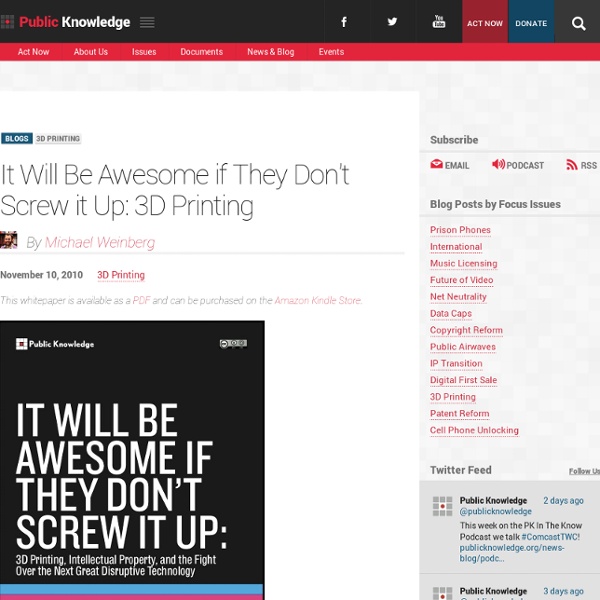



L’impression 3D, ce sera formidable… s’ils ne foutent pas tout en l’air ! | Dico Micro L’impression 3D est en train de naître sous nos yeux. Demain il sera ainsi possible de reproduire toute sorte d’objets chez nous aussi facilement, ou presque, qu’un texte numérique se couche sur le papier à l’aide de notre bonne vieille imprimante 2D. Les conséquences potentielles de la démocratisation d’un tel outil donnent le vertige et suscitent espoir et enthousiasme parmi les makers du monde entier[1]. Pour rappel, l’impression 3D est une technique qui permet de produire un objet réel à partir d’un fichier CAO en le découpant en tranches puis en déposant ou solidifiant de la matière (plastique, cire, métal…) couche par couche pour, en fin de compte, obtenir la pièce terminée. Si le concept et la technologie vous semblent encore un peu obscurs, je vous invite à regarder cette courte vidéo. Pour le moment on se déplace donc chez ceux qui disposent d’une telle imprimante, imprimante encore rudimentaires dans ses possibilités. On ne s’en étonnera pas. Introduction L’impression 3D
Robot Spiders Weave Products from Plastic in a New Spin on 3-D Printing Siemens is testing teams of creepy-crawly 3-D-printing robots. Their descendants might make manufacturing lines far more efficient. If you’re afraid of spiders, then you might find Siemens’s vision for future manufacturing lines a bit alarming. In a lab in Princeton, New Jersey, the company’s researchers are testing spider-like robots that extrude not silk but plastic, thanks to portable 3-D printers. The work is at an early stage, but it hints at where manufacturing may be headed, thanks to more sophisticated robot hardware, smarter control software, and new ways of forming components using 3-D printing. Livio Dalloro, head of product design, modeling, and simulation at Siemens, says that the robots (which, unlike actual spiders, have only six legs) can currently produce only very simple objects, like cubes, but the idea is that they would eventually clamber around a larger, more complex object, building it as they go.
Digital Designs for Physical Objects The cat Made by PP3DP Sep 8, 2010 Source Description No description provided. Top Can HP Make 3-D Printing into a Mass Manufacturing Technique? The tech giant says its new $130,000 printers will produce plastic parts quickly and inexpensively. Despite the flexibility of 3-D printing, it still cannot compete with conventional injection molding for making large volumes of high-strength plastic parts. Hewlett-Packard says its new printing technology will change that. Today HP will begin taking orders for systems that print parts in a process it calls Jet Fusion. Jet Fusion is best compared to laser sintering, in which a laser is used to heat granules of polymer powder and fuse them to build objects layer by layer. HP says its technology is up to 10 times faster than laser sintering. Once the inks are printed according to digital instructions, a high-intensity light source passes over the whole print surface, heating the powder and fusing it wherever the fusing agent is. HP is not the first company to claim that its printing technology can compete head-on with injection molding.
DIYLILCNC